Directors of South Florida’s three largest ports talk trade
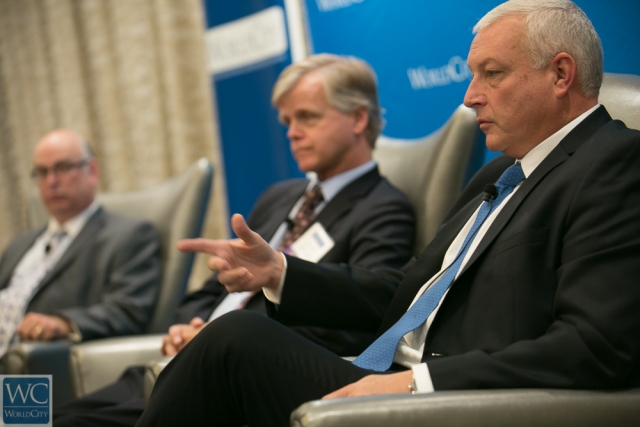
For South Florida trade to really take off, airports and seaports need more than new routes to Asia. They also need lots more funding to expand and upgrade facilities.
That was the view from directors of South Florida’s three largest ports, who shared the stage May 1 at WorldCity’s Trade Connections. The luncheon kicked off activities for World Trade Month and presented WorldCity’s annual Miami TradeNumbers publication.
Headlining the event were Juan Kuryla, seaport director of PortMiami; Steven Cernak, director of Fort Lauderdale’s seaport Port Everglades; and Emilio T. González, director of the Miami-Dade Aviation Department that runs Miami International Airport.
Funding for infrastructure needed
Asked about the biggest issue affecting South Florida trade, both seaport leaders pointed to the need to improve infrastructure, as the region’s population grows and ships get bigger.
Projects such as deepening port channels to handle mega-ships can cost hundreds of millions of dollars.
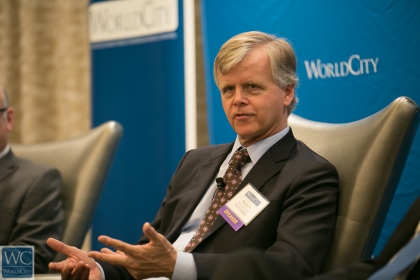
Steven Cernak, director of Fort Lauderdale’s seaport Port Everglades. Photos by Carlos Miller
“The state stepped up,” Cernak said, referring to state money for recent upgrades at Port Everglades. But even larger funding needed from the federal government has been slow to come. “Until the logjam gets resolved in Washington, it’s continuing to be a problem” to obtain federal funds, said Cernak.
Port Everglades plans to spend $1.6 billion over the next 20 years on port upgrades, Cernak said.
Kuryla said the contrast between the United States and Asia is clear: “I just came back from China. When you look how they are continuing to develop the infrastructure, we are falling behind.”
Yet Kuryla also gave credit to the state and Gov. Rick Scott for championing two big projects at his seaport: the newly opened Port Tunnel, which links Interstate-395 to the seaport and diverts truck from downtown; and the Deep Dredge now underway, which will deepen the channel to host the mega- ships that will soon cross the expanded Panama Canal.
Are the directors also thinking about a direct link from the airport to the seaports, perhaps even one that could bring passengers straight to cruiseships?, asked Jack Lowell, executive vice president at the Pointe Group Advisors real estate brokerage and management firm.
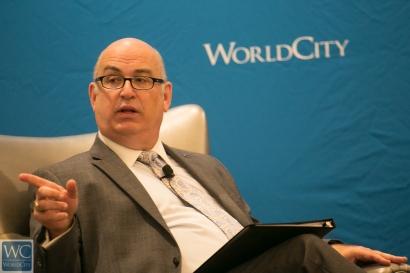
Emilio T. González, director of the Miami-Dade Aviation Department that runs Miami International Airport.
“We don’t have a mentality that “Build it and they will come,’” said Miami aviation chief González. The big challenge is figuring out how to pay for projects. “Our businesses have to grow, and they have to make money. We have to be very judicious.”
One area clearly growing for Miami International Airport is cargo. MIA ranks No. 1 in the United States for international air cargo, thanks largely to imports of flowers, fish and other perishables and exports of such high-tech items as cellphones and medical devices.
MIA now is working to create a pharmaceutical hub to expand its cargo business. “We can’t just do more of the same,” said Gonzalez.
Boosting business with Asia
Many in the audience wanted to know about opportunities to boost commerce with Asia.
“Can you expand on what it will take to be further into the China trade?” asked Joe Rasco, who leads intergovernmental affairs for Miami-Dade County.
“China is clearly a target for us,” González said. The strategy is to take advantage of existing route networks and build on them. For example, flights between Miami and Taipei would draw on traffic not only from Taiwan, but also from Japan, Korea and mainland China, he said.
González said MIA polls passengers for interest and also, keeps track of which airlines are purchasing planes to encourage service to Miami. “We have to get out in front of people,” he said.
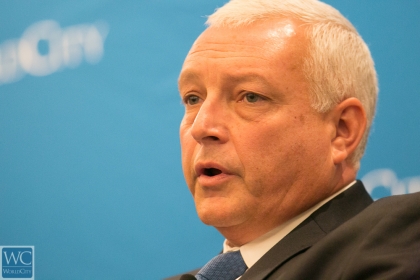
Juan Kuryla, seaport director of PortMiami.
What may surprise those who think trade centers on routes and rates is that all three directors said the key to their business is human-to-human connections with counterparts, clients and customers around the world.
“This industry is all about relationships,” Cernak said.
“This is a people business,” agreed Kuryla. “I’m never going to go away from the one-to-one relationships I and my staff have.”
Top trade partners for Miami in 2014
The talks came after the Miami Customs District – spanning airports and seaports from Key West to Fort Pierce – saw a dip in its trade with the world last year. The area’s direct trade in goods with overseas ports fell for the second year in a row, down 3.89 percent to $115.93 billion in 2014.
Still, that remains the third-highest trade total on record for the Miami area, TradeNumbers show.
WorldCity CEO Ken Roberts linked the dip largely to a drop in commodity prices and the shutdown of an Intel Corp. factory in Costa Rica that had shipped its big ouput of computer chips through Miami. Intel moved that production to Malaysia and now sends those chips through U.S. west coast ports.
Even so, two exports from Miami set records in 2014: medicines and medical devices. That’s because the growing middle classes in Latin America now can afford better health care and buy those health care products through South Florida, said Roberts.
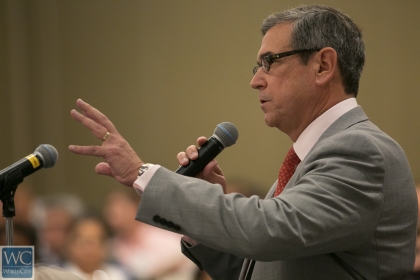
Joe Rasco, who leads intergovernmental affairs for Miami-Dade County.
Miami’s imports from Asia also jumped last year, especially for cellphones and fish. “The reason for fish is that we are all trying to eat healthier,” said Roberts.
Other highlights of 2014 Miami TradeNumbers:
- Miami ranked No. 12 among all U.S. Customs districts for trade in 2014, the same as in 2013.
- Miami accounted for more than 75 percent of all Florida trade in 2014.
- Brazil remains Miami’s No. 1 trade partner, accounting for $16.96 billion in goods traded.
- Hong Kong moved up 11 positions to No. 17 among Miami trade partners, with $2.09 billion in goods traded.
- Italy returned to the top 20, finishing at No. 18 with more than $2 billion in trade.
- Switzerland, which ranked No. 3 in 2012, came in at No. 21, as demand for gold diminished.
Trade Connections is one of five event series organized by WorldCity to bring together executives in greater Miami on international business topics. The Trade series is sponsored by PortMiami, MIA, AmericanAirlines Cargo, HSBC and the Florida Small Business Development Center at Florida International University’s School of Business. The trade data featured is also avaialble at ustradenumbers.com with over 4,000 interactive stories including trade figures by ports, countries, customs districts and commodities!
The next Trade Connections event is set for June 19.